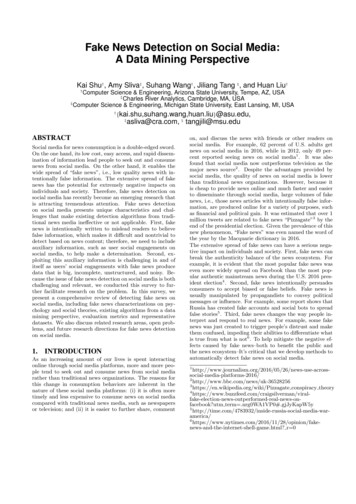
Transcription
Fake News Detection on Social Media:A Data Mining PerspectiveKai Shu† , Amy Sliva‡ , Suhang Wang† , Jiliang Tang \ , and Huan Liu††Computer Science & Engineering, Arizona State University, Tempe, AZ, USA‡Charles River Analytics, Cambridge, MA, USA\Computer Science & Engineering, Michigan State University, East Lansing, MI, liva@cra.com, \ tangjili@msu.eduABSTRACTSocial media for news consumption is a double-edged sword.On the one hand, its low cost, easy access, and rapid dissemination of information lead people to seek out and consumenews from social media. On the other hand, it enables thewide spread of “fake news”, i.e., low quality news with intentionally false information. The extensive spread of fakenews has the potential for extremely negative impacts onindividuals and society. Therefore, fake news detection onsocial media has recently become an emerging research thatis attracting tremendous attention. Fake news detectionon social media presents unique characteristics and challenges that make existing detection algorithms from traditional news media ineffective or not applicable. First, fakenews is intentionally written to mislead readers to believefalse information, which makes it difficult and nontrivial todetect based on news content; therefore, we need to includeauxiliary information, such as user social engagements onsocial media, to help make a determination. Second, exploiting this auxiliary information is challenging in and ofitself as users’ social engagements with fake news producedata that is big, incomplete, unstructured, and noisy. Because the issue of fake news detection on social media is bothchallenging and relevant, we conducted this survey to further facilitate research on the problem. In this survey, wepresent a comprehensive review of detecting fake news onsocial media, including fake news characterizations on psychology and social theories, existing algorithms from a datamining perspective, evaluation metrics and representativedatasets. We also discuss related research areas, open problems, and future research directions for fake news detectionon social media.1.INTRODUCTIONAs an increasing amount of our lives is spent interactingonline through social media platforms, more and more people tend to seek out and consume news from social mediarather than traditional news organizations. The reasons forthis change in consumption behaviors are inherent in thenature of these social media platforms: (i) it is often moretimely and less expensive to consume news on social mediacompared with traditional news media, such as newspapersor television; and (ii) it is easier to further share, commenton, and discuss the news with friends or other readers onsocial media. For example, 62 percent of U.S. adults getnews on social media in 2016, while in 2012, only 49 percent reported seeing news on social media1 . It was alsofound that social media now outperforms television as themajor news source2 . Despite the advantages provided bysocial media, the quality of news on social media is lowerthan traditional news organizations. However, because itis cheap to provide news online and much faster and easierto disseminate through social media, large volumes of fakenews, i.e., those news articles with intentionally false information, are produced online for a variety of purposes, suchas financial and political gain. It was estimated that over 1million tweets are related to fake news “Pizzagate”3 by theend of the presidential election. Given the prevalence of thisnew phenomenon, “Fake news” was even named the word ofthe year by the Macquarie dictionary in 2016.The extensive spread of fake news can have a serious negative impact on individuals and society. First, fake news canbreak the authenticity balance of the news ecosystem. Forexample, it is evident that the most popular fake news waseven more widely spread on Facebook than the most popular authentic mainstream news during the U.S. 2016 president election4 . Second, fake news intentionally persuadesconsumers to accept biased or false beliefs. Fake news isusually manipulated by propagandists to convey politicalmessages or influence. For example, some report shows thatRussia has created fake accounts and social bots to spreadfalse stories5 . Third, fake news changes the way people interpret and respond to real news. For example, some fakenews was just created to trigger people’s distrust and makethem confused, impeding their abilities to differentiate whatis true from what is not6 . To help mitigate the negative effects caused by fake news–both to benefit the public andthe news ecosystem–It’s critical that we develop methods toautomatically detect fake news on social iki/Pizzagate conspiracy book?utm term ernet-shell-game.html? r 0
Detecting fake news on social media poses several new andchallenging research problems. Though fake news itself isnot a new problem–nations or groups have been using thenews media to execute propaganda or influence operationsfor centuries–the rise of web-generated news on social media makes fake news a more powerful force that challengestraditional journalistic norms. There are several characteristics of this problem that make it uniquely challenging forautomated detection. First, fake news is intentionally written to mislead readers, which makes it nontrivial to detectsimply based on news content. The content of fake news israther diverse in terms of topics, styles and media platforms,and fake news attempts to distort truth with diverse linguistic styles while simultaneously mocking true news. Forexample, fake news may cite true evidence within the incorrect context to support a non-factual claim [22]. Thus,existing hand-crafted and data-specific textual features aregenerally not sufficient for fake news detection. Other auxiliary information must also be applied to improve detection, such as knowledge base and user social engagements.Second, exploiting this auxiliary information actually leadsto another critical challenge: the quality of the data itself.Fake news is usually related to newly emerging, time-criticalevents, which may not have been properly verified by existing knowledge bases due to the lack of corroborating evidence or claims. In addition, users’ social engagementswith fake news produce data that is big, incomplete, unstructured, and noisy [79]. Effective methods to differentiate credible users, extract useful post features and exploitnetwork interactions are an open area of research and needfurther investigations.In this article, we present an overview of fake news detectionand discuss promising research directions. The key motivations of this survey are summarized as follows: Fake news on social media has been occurring for several years; however, there is no agreed upon definitionof the term “fake news”. To better guide the futuredirections of fake news detection research, appropriateclarifications are necessary. Social media has proved to be a powerful source forfake news dissemination. There are some emergingpatterns that can be utilized for fake news detectionin social media. A review on existing fake news detection methods under various social media scenarios canprovide a basic understanding on the state-of-the-artfake news detection methods. Fake news detection on social media is still in the earlyage of development, and there are still many challenging issues that need further investigations. It is necessary to discuss potential research directions that canimprove fake news detection and mitigation capabilities.To facilitate research in fake news detection on social media, in this survey we will review two aspects of the fakenews detection problem: characterization and detection. Asshown in Figure 1, we will first describe the background ofthe fake news detection problem using theories and properties from psychology and social studies; then we presentthe detection approaches. Our major contributions of thissurvey are summarized as follows: We discuss the narrow and broad definitions of fakenews that cover most existing definitions in the literature and further present the unique characteristics offake news on social media and its implications compared with the traditional media; We give an overview of existing fake news detectionmethods with a principled way to group representativemethods into different categories; and We discuss several open issues and provide future directions of fake news detection in social media.The remainder of this survey is organized as follows. InSection 2, we present the definition of fake news and characterize it by comparing different theories and properties inboth traditional and social media. In Section 3, we continueto formally define the fake news detection problem and summarize the methods to detect fake news. In Section 4, wediscuss the datasets and evaluation metrics used by existingmethods. We briefly introduce areas related to fake news detection on social media in Section 5. Finally, we discuss theopen issues and future directions in Section 6 and concludethis survey in Section 7.2.FAKE NEWS CHARACTERIZATIONIn this section, we introduce the basic social and psychological theories related to fake news and discuss more advancedpatterns introduced by social media. Specifically, we firstdiscuss various definitions of fake news and differentiate related concepts that are usually misunderstood as fake news.We then describe different aspects of fake news on traditional media and the new patterns found on social media.2.1Definitions of Fake NewsFake news has existed for a very long time, nearly the sameamount of time as news began to circulate widely after theprinting press was invented in 14397 . However, there is noagreed definition of the term “fake news”. Therefore, we firstdiscuss and compare some widely used definitions of fakenews in the existing literature, and provide our definition offake news that will be used for the remainder of this survey.A narrow definition of fake news is news articles that are intentionally and verifiably false and could mislead readers [2].There are two key features of this definition: authenticityand intent. First, fake news includes false information thatcan be verified as such. Second, fake news is created withdishonest intention to mislead consumers. This definitionhas been widely adopted in recent studies [57; 17; 62; 41].Broader definitions of fake news focus on the either authenticity or intent of the news content. Some papers regardsatire news as fake news since the contents are false eventhough satire is often entertainment-oriented and reveals itsown deceptiveness to the consumers [67; 4; 37; 9]. Otherliterature directly treats deceptive news as fake news [66],which includes serious fabrications, hoaxes, and satires.In this article, we use the narrow definition of fake news.Formally, we state this definition as follows,Definition 1 (Fake News) Fake news is a news articlethat is intentionally and verifiably /12/fakenews-history-long-violent-214535
Figure 1: Fake news on social media: from characterization to detection.The reasons for choosing this narrow definition are threefolds. First, the underlying intent of fake news provides boththeoretical and practical value that enables a deeper understanding and analysis of this topic. Second, any techniquesfor truth verification that apply to the narrow conceptionof fake news can also be applied to under the broader definition. Third, this definition is able to eliminate the ambiguities between fake news and related concepts that are notconsidered in this article. The following concepts are notfake news according to our definition: (1) satire news withproper context, which has no intent to mislead or deceiveconsumers and is unlikely to be mis-perceived as factual;(2) rumors that did not originate from news events; (3) conspiracy theories, which are difficult verify as true or false;(4) misinformation that is created unintentionally; and (5)hoaxes that are only motivated by fun or to scam targetedindividuals.2.2Fake News on Traditional News MediaFake news itself is not a new problem. The media ecologyof fake news has been changing over time from newsprint toradio/television and, recently, online news and social media.We denote “traditional fake news” as the fake news problembefore social media had important effects on its productionand dissemination. Next, we will describe several psychological and social science foundations that describe the impactof fake news at both the individual and social informationecosystem levels.Psychological Foundations of Fake News. Humans arenaturally not very good at differentiating between real andfake news. There are several psychological and cognitivetheories that can explain this phenomenon and the influential power of fake news. Traditional fake news mainly targets consumers by exploiting their individual vulnerabilities.There are two major factors which make consumers naturally vulnerable to fake news: (i) Naı̈ve Realism: consumerstend to believe that their perceptions of reality are the onlyaccurate views, while others who disagree are regarded asuninformed, irrational, or biased [92]; and (ii) ConfirmationBias: consumers prefer to receive information that confirmstheir existing views [58]. Due to these cognitive biases inherent in human nature, fake news can often be perceived as realby consumers. Moreover, once the misperception is formed,it is very hard to correct it. Psychology studies shows thatcorrection of false information (e.g., fake news) by the presentation of true, factual information is not only unhelpfulto reduce misperceptions, but sometimes may even increasethe misperceptions, especially among ideological groups [59].Social Foundations of the Fake News Ecosystem.Considering the entire news consumption ecosystem, we canalso describe some of the social dynamics that contribute tothe proliferation of fake news. Prospect theory describesdecision making as a process by which people make choicesbased on the relative gains and losses as compared to theircurrent state [39; 81]. This desire for maximizing the rewardof a decision applies to social gains as well, for instance,continued acceptance by others in a user’s immediate socialnetwork. As described by social identity theory [76; 77] andnormative influence theory [3; 40], this preference for socialacceptance and affirmation is essential to a person’s identityand self-esteem, making users likely to choose “socially safe”options when consuming and disseminating news information, following the norms established in the community evenif the news being shared is fake news.This rational theory of fake news interactions can be modeled from an economic game theoretical perspective [26] byformulating the news generation and consumption cycle as atwo-player strategy game. For explaining fake news, we assume there are two kinds of key players in the informationecosystem: publisher and consumer. The process of newspublishing is modeled as a mapping from original signal sto resultant news report a with an effect of distortion biasbb, i.e., s a, where b [ 1, 0, 1] indicates [lef t, no, right]biases take effects on news publishing process. Intuitively,this is capturing the degree to which a news article may bebiased or distorted to produce fake news. The utility forthe publisher stems from two perspectives: (i) short-termutility: the incentive to maximize profit, which is positivelycorrelated with the number of consumers reached; (ii) longterm utility: their reputation in terms of news authenticity.Utility of consumers consists of two parts: (i) informationutility: obtaining true and unbiased information (usually extra investment cost needed); (ii) psychology utility: receivingnews that satisfies their prior opinions and social needs, e.g.,confirmation bias and prospect theory. Both publisher andconsumer try to maximize their overall utilities in this strategy game of the news consumption process. We can capturethe fact that fake news happens when the short-term utilitydominates a publisher’s overall utility and psychology utilitydominates the consumer’s overall utility, and an equilibriumis maintained. This explains the social dynamics that leadto an information ecosystem where fake news can thrive.
2.3Fake News on Social MediaIn this subsection, we will discuss some unique characteristics of fake news on social media. Specifically, we willhighlight the key features of fake news that are enabled bysocial media. Note that the aforementioned characteristicsof traditional fake news are also applicable to social media.Malicious Accounts on Social Media for Propaganda.While many users on social media are legitimate, social media users may also be malicious, and in some cases are noteven real humans. The low cost of creating social mediaaccounts also encourages malicious user accounts, such associal bots, cyborg users, and trolls. A social bot refers toa social media account that is controlled by a computer algorithm to automatically produce content and interact withhumans (or other bot users) on social media [23]. Social botscan become malicious entities designed specifically with thepurpose to do harm, such as manipulating and spreadingfake news on social media. Studies shows that social botsdistorted the 2016 U.S. presidential election online discussions on a large scale [6], and that around 19 million botaccounts tweeted in support of either Trump or Clinton inthe week leading up to election day8 . Trolls, real humanusers who aim to disrupt online communities and provokeconsumers into an emotional response, are also playing animportant role in spreading fake news on social media. Forexample, evidence suggests that there were 1,000 paid Russian trolls spreading fake news on Hillary Clinton9 . Trollingbehaviors are highly affected by people’s mood and the context of online discussions, which enables the easy dissemination of fake news among otherwise “normal” online communities [14]. The effect of trolling is to trigger people’sinner negative emotions, such as anger and fear, resultingin doubt, distrust, and irrational behavior. Finally, cyborgusers can spread fake news in a way that blends automatedactivities with human input. Usually cyborg accounts areregistered by human as a camouflage and set automated programs to perform activities in social media. The easy switchof functionalities between human and bot offers cyborg usersunique opportunities to spread fake news [15]. In a nutshell,these highly active and partisan malicious accounts on social media become the powerful sources and proliferation offake news.Echo Chamber Effect. Social media provides a new paradigmof information creation and consumption for users. Theinformation seeking and consumption process are changing from a mediated form (e.g., by journalists) to a moredisinter-mediated way [19]. Consumers are selectively exposed to certain kinds of news because of the way newsfeed appear on their homepage in social media, amplifyingthe psychological challenges to dispelling fake news identified above. For example, users on Facebook always followlike-minded people and thus receive news that promote theirfavored existing narratives [65]. Therefore, users on socialmedia tend to form groups containing like-minded peoplewhere they then polarize their opinions, resulting in an echochamber effect. The echo chamber effect facilitates the ingtonpost.com/entry/russian-trolls-fakenews us 58dde6bae4b08194e3b8d5c4cess by which people consume and believe fake news due tothe following psychological factors [60]: (1) social credibility,which means people are more likely to perceive a source ascredible if others perceive the source is credible, especiallywhen there is not enough information available to access thetruthfulness of the source; and (2) frequency heuristic, whichmeans that consumers may naturally favor information theyhear frequently, even if it is fake news. Studies have shownthat increased exposure to an idea is enough to generate apositive opinion of it [100; 101], and in echo chambers, userscontinue to share and consume the same information. As aresult, this echo chamber effect creates segmented, homogeneous communities with a very limited information ecosystem. Research shows that the homogeneous communitiesbecome the primary driver of information diffusion that further strengthens polarization [18].3.FAKE NEWS DETECTIONIn the previous section, we introduced the conceptual characterization of traditional fake news and fake news in social media. Based on this characterization, we further explore the problem definition and proposed approaches forfake news detection.3.1Problem DefinitionIn this subsection, we present the details of mathematicalformulation of fake news detection on social media. Specifically, we will introduce the definition of key componentsof fake news and then present the formal definition of fakenews detection. The basic notations are defined below, Let a refer to a News Article. It consists of two major components: Publisher and Content. Publisher p aincludes a set of profile features to describe the original author, such as name, domain, age, among otherattributes. Content c a consists of a set of attributesthat represent the news article and includes headline,text, image, etc. We also define Social News Engagements as a set oftuples E {eit } to represent the process of how newsspread over time among n users U {u1 , u2 , ., un }and their corresponding posts P {p1 , p2 , ., pn } onsocial media regarding news article a. Each engagement eit {ui , pi , t} represents that a user ui spreadsnews article a using pi at time t. Note that we sett N ull if the article a does not have any engagement yet and thus ui represents the publisher.Definition 2 (Fake News Detection) Given the socialnews engagements E among n users for news article a, thetask of fake news detection is to predict whether the newsarticle a is a fake news piece or not, i.e., F : E {0, 1}such that,(1,F(a) 0,if a is a piece of fake news,otherwise.(1)where F is the prediction function we want to learn.Note that we define fake news detection as a binary classification problem for the following reason: fake news is essentially a distortion bias on information manipulated by thepublisher. According to previous research about media bias
theory [26], distortion bias is usually modeled as a binaryclassification problem.Next, we propose a general data mining framework for fakenews detection which includes two phases: (i) feature extraction and (ii) model construction. The feature extractionphase aims to represent news content and related auxiliaryinformation in a formal mathematical structure, and modelconstruction phase further builds machine learning modelsto better differentiate fake news and real news based on thefeature representations.3.2Feature ExtractionFake news detection on traditional news media mainly relieson news content, while in social media, extra social contextauxiliary information can be used to as additional information to help detect fake news. Thus, we will present thedetails of how to extract and represent useful features fromnews content and social context.3.2.1News Content FeaturesNews content features c a describe the meta information related to a piece of news. A list of representative news contentattributes are listed below: Source: Author or publisher of the news article Headline: Short title text that aims to catch the attention of readers and describes the main topic of thearticle Body Text: Main text that elaborates the details ofthe news story; there is usually a major claim that isspecifically highlighted and that shapes the angle ofthe publisher Image/Video: Part of the body content of a newsarticle that provides visual cues to frame the storyBased on these raw content attributes, different kinds offeature representations can be built to extract discriminativecharacteristics of fake news. Typically, the news content weare looking at will mostly be linguistic-based and visualbased, described in more detail below.Linguistic-based: Since fake news pieces are intentionally created for financial or political gain rather than to report objective claims, they often contain opinionated andinflammatory language, crafted as “clickbait” (i.e., to entice users to click on the link to read the full article) orto incite confusion [13]. Thus, it is reasonable to exploitlinguistic features that capture the different writing stylesand sensational headlines to detect fake news. Linguisticbased features are extracted from the text content in termsof document organizations from different levels, such as characters, words, sentences, and documents. In order to capture the different aspects of fake news and real news, existing work utilized both common linguistic features anddomain-specific linguistic features. Common linguistic features are often used to represent documents for various tasksin natural language processing. Typical common linguistic features are: (i) lexical features, including characterlevel and word-level features, such as total words, characters per word, frequency of large words, and unique words;(ii) syntactic features, including sentence-level features, suchas frequency of function words and phrases (i.e., “n-grams”and bag-of-words approaches [24]) or punctuation and partsof-speech (POS) tagging. Domain-specific linguistic features, which are specifically aligned to news domain, suchas quoted words, external links, number of graphs, and theaverage length of graphs, etc [62]. Moreover, other featurescan be specifically designed to capture the deceptive cuesin writing styles to differentiate fake news, such as lyingdetection features [1].Visual-based: Visual cues have been shown to be an important manipulator for fake news propaganda10 . As wehave characterized, fake news exploits the individual vulnerabilities of people and thus often relies on sensational or evenfake images to provoke anger or other emotional response ofconsumers. Visual-based features are extracted from visualelements (e.g. images and videos) to capture the differentcharacteristics for fake news. Faking images were identifiedbased on various user-level and tweet-level hand-crafted features using classification framework [28]. Recently, variousvisual and statistical features has been extracted for newsverification [38]. Visual features include clarity score, coherence score, similarity distribution histogram, diversity score,and clustering score. Statistical features include count, image ratio, multi-image ratio, hot image ratio, long imageratio, etc.3.2.2Social Context FeaturesIn addition to features related directly to the content ofthe news articles, additional social context features can alsobe derived from the user-driven social engagements of newsconsumption on social media platform. Social engagementsrepresent the news proliferation process over time, whichprovides useful auxiliary information to infer the veracity ofnews articles. Note that few papers exist in the literaturethat detect fake news using social context features. However, because we believe this is a critical aspect of successfulfake news detection, we introduce a set of common featuresutilized in similar research areas, such as rumor veracityclassification on social media. Generally, there are threemajor aspects of the social media context that we want torepresent: users, generated posts, and networks. Below, weinvestigate how we can extract and represent social contextfeatures from these three aspects to support fake news detection.User-based: As we mentioned in Section 2.3, fake newspieces are likely to be created and spread by non-humanaccounts, such as social bots or cyborgs. Thus, capturingusers’ profiles and characteristics by user-based features canprovide useful information for fake news detection. Userbased features represent the characteristics of those userswho have interactions with the news on social media. Thesefeatures can be categorized across different levels: individuallevel and group level. Individual level features are extractedto infer the credibility and reliability for each user usingvarious aspects of user demographics, such as registrationage, number of followers/followees, number of tweets theuser has authored, etc [11]. Group level user features capture overall characteristics of groups of users related to thenews [99]. The assumption is that the spreaders of fake read-fakenews/
and real news may form different communities with uniquecharacteristics that can be depicted by group level features.Commonly used group level features come from aggregating (e.g., averaging and weighting) individual level features,such as ‘percentage of verified users’ and ‘average numberof followers’ [49; 42].are properly built, existing network metrics can be appliedas feature representations. For example, degree and clustering coefficient have been used to characterize the diffusionnetwork [42] and friendship network [42]. Other approacheslearn the latent node embedding features by using SVD [69]or network propagation algorithms [37].Post-based: People express their emotions or opinions towards fake news through social me
chology and social theories, existing algorithms from a data mining perspective, evaluation metrics and representative datasets. We also discuss related research areas, open prob-lems, and future research directions for fake news detection on social media. 1. INTRODUCTION As an increasing amount of our lives is spent interacting
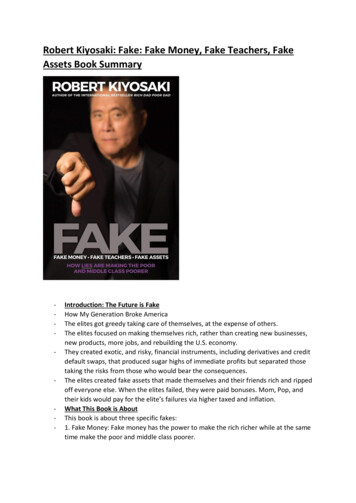
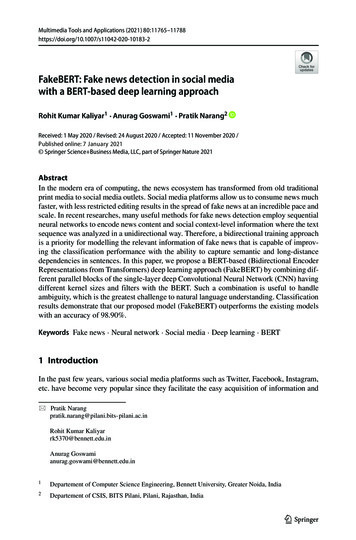


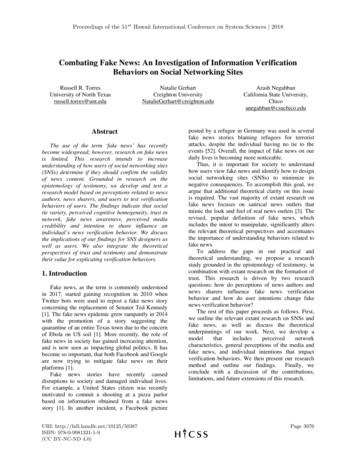
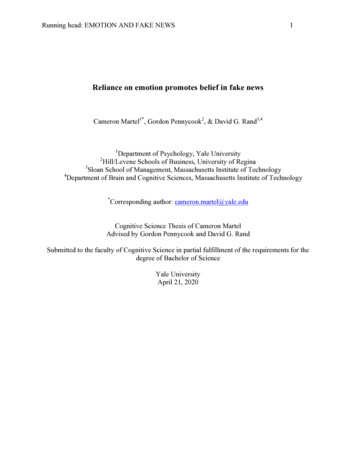
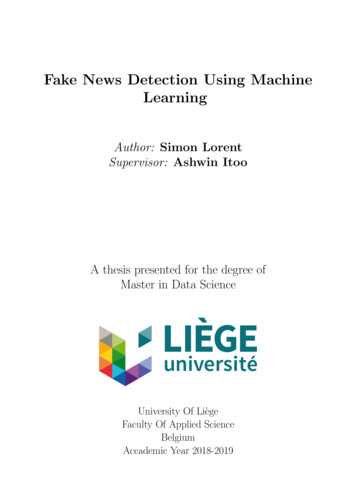
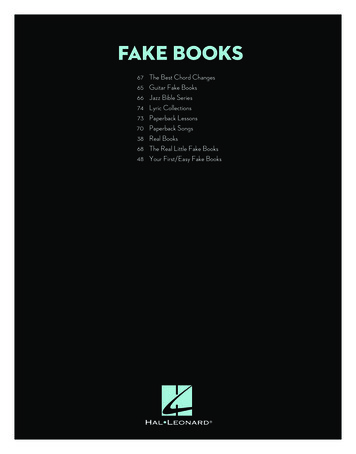
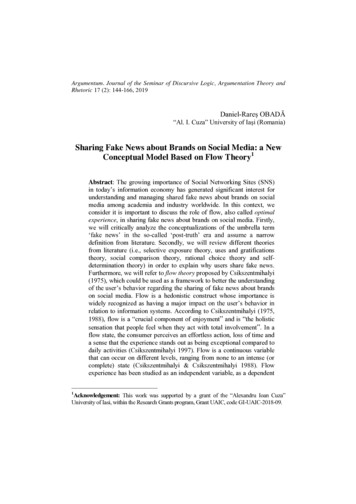
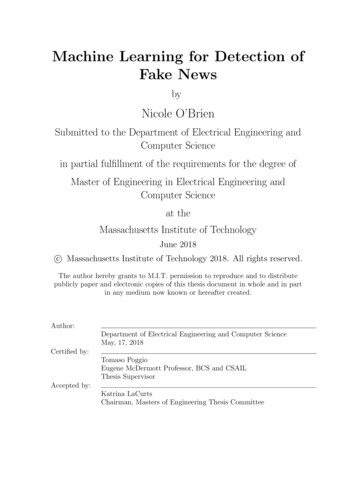
![Fake Notepad Crack Free X64 [Latest 2022]](/img/41/fake-notepad-crack-free-download-x64-latest-2022.jpg)